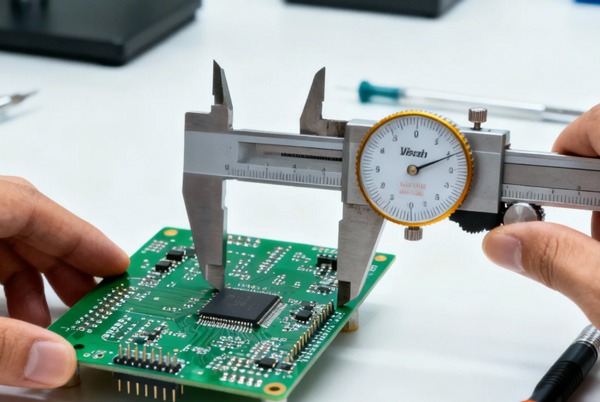Table of Contents
Electrical Characteristic Inspection Solutions
(1) Has the influence of conductor resistance, inductance, and capacitance been analyzed?
Solution: Adopt a combined method of simulation analysis and actual testing. Use SI/PI simulation tools (e.g., HyperLynx, ADS) to extract parasitic parameters before layout, analyzing high-frequency signal integrity and power delivery network impedance. For high-speed circuits, implement impedance matching design and topology optimization, verified by Time Domain Reflectometry measurements. Establish PCB design rules, setting strict length and width matching requirements for critical signal lines (e.g., clocks, differential pairs). Use the four-wire method to measure milliohm-level conductor resistance, a network analyzer for inductance parameters, and an LCR meter for distributed capacitance. Compare results with design specifications to ensure parasitic parameters are within allowable limits, preventing signal distortion, timing issues, and electromagnetic interference.
(2) Do the spacing and shape of conductor attachments meet insulation requirements?
Solution: Implement dual verification of DFM (Design for Manufacturability) and DFA (Design for Reliability). Determine minimum spacing according to voltage level based on IPC-2221 standards (e.g., 0.1mm spacing for 100V DC). Use CAM software for automatic spacing checks, implementing reinforced insulation design for high-voltage areas (e.g., power modules). Optimize conductor corners using 45-degree angles or arcs to avoid electric field concentration from sharp angles. Perform withstand voltage tests, applying 2-3 times the operating voltage for 1 minute, ensuring no breakdown occurs. Implement electromagnetic field simulation for high-frequency circuits, analyzing fringe field effects to ensure insulation requirements are met under actual operating conditions.
(3) Are insulation resistance values controlled and specified at critical locations?
Solution: Establish a critical point insulation resistance control system. Identify key areas such as high-voltage zones, high-frequency circuits, and high-impedance applications, marking insulation resistance test points in the design. Select appropriate insulating materials (e.g., FR-4, polyimide) according to IEC-60112 standards, with surface treatment using solder mask. Use an insulation resistance tester (e.g., megohmmeter) to measure at 500V DC, ensuring insulation resistance ≥100MΩ at key locations (≥10MΩ under high temperature/humidity). Implement accelerated life testing, monitoring insulation resistance decay over 500 hours at 85°C/85% RH, ensuring the product meets safety standards throughout its lifecycle.
(4) Is polarity fully identified?
Solution: Build a multiple-polarity identification and error-proofing system. During PCB layout, use standardized packages for polar components (e.g., electrolytic capacitors, diodes, connectors), clearly marking polarity symbols (+, – △) on the silkscreen layer. Establish a DFA checklist requiring polarity mark size ≥1.5mm, positioned ≤0.5mm from the component body. Use asymmetric package designs to prevent 180-degree misinsertion. In the assembly process, set up AOI (Automated Optical Inspection) polarity check stations, using color recognition technology to distinguish polarity direction. Create first-article samples before mass production, verified by 3 independent personnel 3 times, ensuring the polarity identification system is reliable and effective.
(5) Has the influence of conductor spacing on leakage resistance and voltage been evaluated from a geometric perspective?
Solution: Implement collaborative electrical performance design based on geometric parameters. Use electromagnetic field simulation software (e.g., ANSYS HFSS) to create PCB geometric models, analyzing the electric field distribution and leakage current at different spacings. Establish a spacing-voltage reference table according to IPC-2221A standards (e.g., 0.1mm for 50V, 0.2mm for 100V). Use slot designs for high-voltage applications to increase creepage distance, and implement grounded coplanar waveguide structures for high-frequency signals. Verify impedance continuity via TDR measurements, using a surface resistance tester to measure leakage resistance. Establish a design rule library linking geometric parameters to electrical performance, enabling automated checking and optimization.
(6) Have the media of changed surface coatings been certified?
Solution: Establish a surface coating change certification process. Any coating change must pass complete qualification testing, including adhesion test (cross-cut ≥4B), chemical resistance test (resisting flux, cleaners), and dielectric constant measurement (1kHz-1GHz band). Perform damp heat cycling tests (-40°C to +85°C, 1000 cycles) to evaluate insulation resistance stability. Use SEM to analyze coating thickness uniformity (target 15-30μm). For high-frequency circuits, measure the coating’s impact on signal loss (≤0.02dB/inch). Establish a qualified supplier list, requiring material certificates and RoHS compliance certificates for each batch, ensuring consistent and reliable coating performance.

Physical Characteristic Inspection Solutions
(1) Are all pads and their positions suitable for final assembly?
Solution: Implement DFA-based pad optimization design. Use 3D modeling software (e.g., SolidWorks PCB) for virtual assembly, verifying component pad-to-housing clearance (≥0.5mm). Optimize pad dimensions according to IPC-7351 standards, establishing a component library update mechanism. Implement a pad steal design for BGA devices to prevent solder bridging. Use stepped pad designs to address height restrictions. Create assembly verification fixtures for actual insertion testing. Establish pad design specifications, clearly defining solder mask dam size (≥0.1mm), pad-to-trace transition ratios, ensuring solder yield ≥99.5%.
(2) Does the assembled printed circuit board meet shock and vibration conditions?
Solution: Build a mechanical reliability verification system. Select appropriate test standards (e.g., JESD22-B104) based on the product application environment (e.g., automotive, industrial). Perform modal analysis during the design phase to avoid coincident natural frequencies with operating frequencies (safety factor ≥1.35). Add mechanical fixation (e.g., screws, adhesive) for components weighing ≥15g. Conduct vibration tests (5-500Hz, 1 hour per axis) and shock tests (half-sine wave, 50G, 6ms). Use high-speed cameras to analyze board assembly dynamic response, and strain gauges to measure stress at key points. Optimize PCB support point layout, ensuring no component detachment, solder joint cracks, or other failures after reliability testing.
(3) What is the spacing of the specified standard components?
Solution: Establish component spacing standards based on process capability. Develop tiered spacing specifications according to IPC-7351 and actual factory process levels: chip components ≥0.3mm, SOIC devices ≥0.6mm, QFP devices ≥0.8mm, BGA devices ≥0.5mm. Add an additional 0.5mm clearance for components beneath heat sinks. Automatically validate spacing compliance using DFM inspection software. Implement a local spacing exemption process for high-density designs, subject to process validation. Establish a component database containing 3D models and recommended spacing. New components must undergo spacing compatibility review before being added to the database to ensure manufacturability.
(4) Are loosely mounted components or heavier parts securely fixed?
Solution: Implement specialized fixation solutions for heavy components. Create a list of components weighing ≥5g or size ≥15mm, mandating mechanical fixation. Use screws + washers for transformers and large electrolytic capacitors, specifying screw torque (e.g., 0.6N·m ±10%). Use high-temperature adhesive for medium-sized components, verifying bond strength after 24 hours at 85°C. Reserve space for fixation structures around heavy components during design. Specify fixation operation procedures in process documents, setting dedicated inspection points for fixation stations. After mechanical shock testing, use X-ray to inspect the solder joint and the fixation structure integrity, ensuring secure fixation.
(5) Is heat dissipation for heating elements correct? Are they isolated from the PCB and other heat-sensitive components?
Solution: Build a thermal design and management verification system. Use thermal simulation software (e.g., FloTHERM) to identify heat sources and thermally sensitive components, optimizing layout spacing (≥5mm between heat sources and thermally sensitive components). Use thermal vias (0.3mm diameter, 1mm pitch) for power devices, connected to internal ground planes for heat dissipation. Ensure thermal grease thickness is 0.1-0.15mm at the interface when adding heat sinks. Perform infrared thermal imaging tests, verifying actual temperatures do not exceed 85% of rated values. Implement thermal isolation measures for high-temperature areas: adding heat shields, using high-temperature solder, and setting up heat dissipation channels. Establish temperature rise test standards, ensuring maximum PCB surface temperature difference ≤25°C.
(6) Are voltage dividers and other multi-lead components correctly positioned?
Solution: Implement precise positioning control for multi-lead components. Use an optical positioning system (e.g., Fiducial Mark), placing ≥2 fiducials around each multi-lead component, 0.5-1mm from pads. For high-precision components like voltage dividers, maintain symmetry and equal-length routing during layout to minimize temperature gradient effects. Use package designs with pad center-to-center accuracy of ±0.05mm. Set component image recognition parameters in the placement program, with rotation tolerance ≤1°. Verify positioning accuracy on the first article using a 3D measuring instrument, sampling every 2 hours during mass production. Establish a multi-lead component database containing recommended layouts and inspection requirements, ensuring positioning consistency.
(7) Is the component arrangement and orientation conducive to inspection?
Solution: Optimize component layout for visual inspection. Develop component orientation standards: unify direction for the same type of component (e.g., all chip pin 1s facing left), polarity marks facing the same direction. Ensure component spacing allows AOI camera viewing angle ≥45°, and 100% probe accessibility. Reserve inspection windows adjacent to bottom-termination components (e.g., QFN). Implement a layered inspection strategy for high-density areas: inspect large components first, then use microscopes for fine-pitch components. Establish a DFA checklist containing 25 visibility criteria. Create inspection fixtures, verifying 100% inspection coverage and ≤0.1% false call rate.

(8) Have all potential interferences between the PCB and the entire board assembly been eliminated?
Solution: Implement system-level interference analysis and elimination strategies. Use 3D modeling for mechanical interference checking, ensuring clearance to housing and connectors ≥0.3mm. Set keep-out zones around tall components, with ≥2mm spacing from adjacent boards. Match coefficients of thermal expansion to avoid structural interference from temperature cycling. Optimize assembly sequence, installing short/small components before tall/large ones. Create rapid prototypes for assembly verification, using feeler gauges to measure critical clearances. Establish an interference check matrix covering all possible combination states, ensuring no risk of physical interference.
(9) Are the dimensions of the positioning holes correct?
Solution: Establish a positioning hole accuracy control system. According to IPC-2221 standards, the positioning hole diameter should be 0.1-0.3mm larger than the fixing pin (for board edge holes) or 0.05-0.1mm larger (for internal holes). For 4-layer boards, set a keep-out zone (≥1.5 times hole diameter) around positioning holes. For plated positioning holes, ensure the inner wall copper thickness ≥25μm for mechanical strength. Check the first article of each PCB batch using pin gauges for hole diameter (tolerance ±0.05mm), and a CMM for hole position accuracy (±0.1mm). Install positioning detection sensors in assembly fixtures, with automatic alarms for anomalies, ensuring 100% positioning reliability.
(10) Are the tolerances complete and reasonable?
Solution: Implement process capability-based tolerance design. Analyze process capability indices (Cp≥1.33, Cpk≥1.0) for each PCB manufacturing and assembly step, setting reasonable tolerances: line width tolerance ±10%, hole position tolerance ±0.05mm, board warpage ≤0.75%. Use statistical tolerance analysis to avoid tolerance stack-up exceeding limits. Implement tightened tolerance control for critical dimensions, e.g., BGA pad diameter tolerance ±0.02mm. Establish a tolerance allocation table, clearly defining responsibilities for design, manufacturing, and assembly. Use GD&T standards on drawings, regularly review tolerance applicability, and continuously optimize based on actual yield data.
(11) Have the physical properties of all coatings been controlled and qualified?
Solution: Establish a full lifecycle quality management system for coatings. Set physical property standards for solder mask, silkscreen, and surface finishes (e.g., ENIG, OSP): solder mask thickness 15-25μm, adhesion ≥4B, hardness ≥6H. Perform sampling inspection for each incoming batch: use thickness gauges for uniformity, cross-cut test for adhesion, wear resistance tester for hardness. Conduct accelerated aging tests (1000 hours at 85°C/85% RH) to verify physical property stability. Establish a material traceability system, strictly control storage conditions (temperature 15-30°C, humidity <60%), clearly mark expiration dates, and ensure consistent and reliable coating performance.
(12) Is the hole-to-lead diameter ratio within an acceptable range?
Solution: Implement aperture and lead matching design controls. According to IPC-2221 standards, set appropriate aspect ratios for different component types: Through-hole components require apertures 0.2-0.4mm larger than lead diameter, with a 0.1-0.3mm solder pad; press-fit components require apertures 0.05-0.1mm larger than lead diameter. Employ DFM analysis software to automatically verify aperture ratio compliance. Implement microvia design for high-density boards while ensuring the aperture ratio does not exceed 10:1 (board thickness: aperture diameter). Fabricate aperture ratio verification prototypes and conduct through-hole solder fill rate testing, requiring a fill rate ≥75%. Establish aperture ratio design specifications; new components must pass aperture ratio compatibility review before inventory acceptance to ensure reliable solderability.
(13) Does the PCB meet Electromagnetic Compatibility (EMC) requirements?
Solution: Build a complete EMC control system from design to test. Implement SI/PI/EMC co-simulation during design to identify potential interference sources and sensitive circuits. Adopt a layered grounding strategy, isolating digital, analog, and power areas. Provide complete reference planes for high-speed signals, avoiding cross splits. Place grounding vias around clock circuits for shielding, and use stripline structures for critical signals. Add necessary filter circuits (e.g., ferrite beads, TVS diodes). Use EMC test equipment (spectrum analyzer, EMI receiver) for pre-compliance testing, diagnosing radiated and conducted emission issues. Through layout/routing optimization, adding shields, etc., ensure compliance with FCC, CE, and other EMC standards, passing certification tests on the first attempt.
